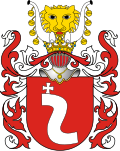Drużyna coat of arms
Polish coat of arms From Wikipedia, the free encyclopedia
Drużyna (Srzeniawa bez Krzyża) is a Polish coat of arms. It was used by several szlachta families in the times of the Kingdom of Poland and the Polish–Lithuanian Commonwealth.
This article includes a list of references, related reading, or external links, but its sources remain unclear because it lacks inline citations. (November 2024) |
Description of the coat of arms
Modern description
In the red field a silver curve. Jewel: Lion's head opposite, between two hunting horns with falcon bells of gold.
Description by Niesiecki
In a field of red, a silver river obliquely, that is, like an S overturned flowing. In the jewel a lion's head of gold without a crown between two hunting trumpets, at each of which hang four bells. Some familiars wear it in such a way that they put a cross on the top of the river and call it Śreniawa, others wear the river without the cross and call it Drużyna. Others do not use the lion on the helmet, but only the trumpets themselves.
History
Summarize
Perspective
The earliest heraldic source mentioning the coat of arms is the Insignia seu clenodia Regis et Regni Poloniae dated 1464–1480 by the Polish historian Jan Długosz, who recognises it as indigenously Polish. He records information about the coat of arms among the 71 oldest Polish noble coats of arms in the passage:"Druszyna a domo Srzenyawa absque cruce in campo rubeo defert Genus Polonicum in effusionem pronum sanguinis, beati Stanislai reum." (latina), "Druszyna from the house of Srzenyawa without a cross in a red field brings the Polish race to the shedding of prone blood, guilty of blessed Stanislaus." (english).
The Drużyna coat of arms is considered by the some historians and heraldic experts to be an earlier version of the Szreniawa coat of arms. Bartosz Paprocki, in his work Herby Rycerstwa Polskiego, references Jan Długosz, who describes the Szreniawity in death of Bishop Stanisław in 1060. According to this account, the original depiction of the Szreniawa coat of arms featured only the river (represented by a wavy line) without the cross that later became characteristic.[AI-generated?]
The use of the Drużyna coat of arms persisted among certain noble families, particularly those associated with Jan Kmita, who served as the starosta of Ruthenia and later Cracow in 1371. These families, often related to the starosta, continued to use this simpler version of the coat of arms, emphasizing their connection to the earlier heraldic tradition.[AI-generated?]
The distinction between the Drużyna and Szreniawa coat of arms marks an evolution in heraldic symbols, reflecting changes in familial alliances, political positions, and possibly the influence of ecclesiastical or regional heraldry. The mention of Drużyna in later records suggests a recognition and perhaps a revival of this original form in certain contexts.[AI-generated?]
The Szreniawa coat of arms is one of the traditional Polish heraldic symbols. Initially, it existed without the cross. In 1371, a version of the Szreniawa coat of arms with a cross was adopted, and the name Szreniawa was retained for this modified emblem. Those who continued using the original version of the coat of arms, which lacked the cross, adopted the name Drużyna to differentiate it from the modified version. This change highlights how heraldic symbols could evolve and be distinguished over time based on specific features, such as the inclusion or exclusion of certain elements like a cross.[AI-generated?]
Notable bearers
Notable bearers of this coat of arms include:
- House of Lubomirski
- Hieronim Augustyn Lubomirski
- Jerzy Sebastian Lubomirski
- Józef Karol Lubomirski
- Stanisław Lubomirski
- Stanisław Herakliusz Lubomirski
- Stanisław Lubomirski (1722-1782)
- Elżbieta Lubomirska
- Stanisław Lubomirski (1583-1649)
- Antoni Benedykt Lubomirski
- Teodor Lubomirski
- Aleksander Michał Lubomirski
- Teresa Lubomirska
- Sebastian Lubomirski
- Katarzyna Lubomirska
- Krystyna Lubomirska (XVII-1645)
- Elżbieta Lubomirska (1669–1729)
Gallery
- Srzeniawa original version
- Srzeniawa
- Princes Lubomirski
Related coat of arms
See also
Bibliography
- Tadeusz Gajl: Herbarz polski od średniowiecza do XX wieku : ponad 4500 herbów szlacheckich 37 tysięcy nazwisk 55 tysięcy rodów. L&L, 2007, s. 406–539. ISBN 978-83-60597-10-1.
- Kasper Niesiecki, Herbarz, VIII, 468-469
Wikiwand - on
Seamless Wikipedia browsing. On steroids.




